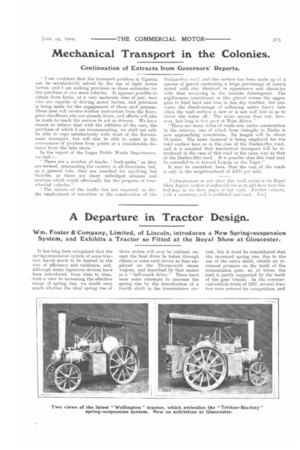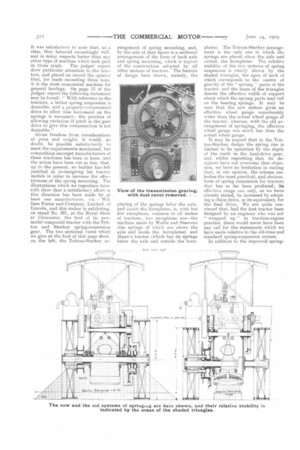A Departure in Tractor Design.
Page 3

Page 4

Page 5

If you've noticed an error in this article please click here to report it so we can fix it.
Wm. Foster $1 Company, Limited, of Lincoln, introduces a New Spring-suspension System, and Exhibits a Tractor so Fitted at the Royal Show at Gloucester.
It has long been recognised that the spring-suspension system of some tractors leaves much to be desired in the way of efficiency and resilience, and, although many ingenious devices have been introduced, from time to time, _ with a view to increasing the effective range of spring rise, we doubt very much whether the ideal spring rise of three inches will ever he realised, except the final drive be taken through chains or some such device as that employed on the Thornycroft steam wagons, and described by that maker as a " bell-crank drive." There have been some attempts to increase the spring rise by the introduction of a fourth shaft in the transmission sys tern, but it must be remembered that the increased spring rise, due to the use of the extra shaft, entails an increased pressure on the teeth of the transmission gear, as, at times, the load is partly supported by the teeth of the gear wheels. In the commercial-vehicle trials of 1907, several tractors were entered for competition, and it was satisfactory to note that, as a class, they behaved exceedingly well and in many respects better than any other type of machine which took part in those trials. The judges' report drew particular attention to the tractors, and placed on record the opinion that, for loads exceeding three tons, it is the most economical machine for general haulage. On page 15 of the judges' report the following statement may be found : " With reference to the tractors, a better spring suspension is desirable, and a properly-compensated drive to allow free movement on the springs is necessary ; the practice of allowing variation of pitch in the gear drive to give this compensation is not desirable."
Given freedom from considerations of price and weight, it would, no doubt, be possible satisfactorily to meet the requirements mentioned, hut competition amongst manufacturers of these machines has been so keen, and the prices have been cut so fine, that. up to the present, no builder has felt justified in re-designing his tractor models in order to increase the effectiveness of the spring mounting. The illustrations which we reproduce herewith show that a satisfactory effort in this direction has been made by at least one manufacturer, viz. : William Foster and Company, Limited, of Lincoln, and this maker is exhibiting, on stand No. 321, at the Royal Show at Gloucester, the first of its newmodel compound tractor with the Tritton and Starkey spring-suspension gear. The two sectional views which we give at the foot of this page allow, on the left, the Tritton-Starkey ar
ran gement of spring mounting, and, by the side of that figure is a sectional arrangement of the form of back axle and spring mounting, which is typical of the construction adopted by all other makers of tractors. The feature of design here shown, namely, the placing of the springs below the axle, and inside the hornplates, is, with but few exceptions, common. to all makes of tractors; two exceptions are—the ma chine made by Wallis and Steevens (the springs of which are above the axle and inside the hornplates) and Mann's tractor (which has its springs below the axle and outside the horn plates). The Tritton-Starkey arrangement is the only one in which the springs are placed above the axle and outside the hornplates. The relative stability of the two systems of spring suspension is clearly shown by the shaded triangles, the apex of each of which corresponds to the centre of gravity of the " sprung " parts of the tractor, and the bases of the triangles denote the effective width of support about which the sprung parts may roll on the bearing springs. It may be seen that the new system gives an effective wheel gauge considerably wider than the actual wheel gauge of the tractor, whereas, with the old arrangement of springing, the effective wheel gauge was much less than the actual wheel gauge.
It may be argued that in the Tritton-Starkey design the spring rise is limited in its operation by the depth of the teeth in the final-drive gear, and, whilst regretting that its designers have not overcome that objecthm, we have no hesitation in stating that, in our opinion, the scheme embodies the most practical, and obvious, farm of spring suspension for tractors that has so far been produced; its effective range can only, as we have already stated, be increased by adopting a chain drive, or its equivalent, for the final drive. We are quite convinced that, had the first tractor been designed by an engineer who was not " wrapped up " in traction-engine practice, there would never have been any call for the statements which we have made relative to the old-time and standard spring-suspension system.
In addition to the improved spring suspension system, William Foster 's new model possesses important features which will be appreciated by tractor users, and not the least of these is the increased driving-wheel diameter, which is now 5 feet 2 inches, as against the 4 feet 6 inches, of the old Wellington models. This increased diameter has been rendered possible by the new spring suspension without increasing the over-all height of the tractor, or the height of its crankshaft centre above the ground. The actual wheel gauge has been increased by a matter of I inch, but this is practically negligible. The wheel base has not been increased, but, on account of the second motion shaft's being placed higher, relative to the crankshaft, the engine seating on the barrel of the boiler has been set forward some five or six inches, which means a little extra weight on the front axle, but, whilst this is extremely small, it has been taken into account in designing the new machine. As a result of moving the engine a few inches, more " elbow room" is allowed the driver in the tender, which now becomes of the " roomiest description." Further, there are no pins, links, compensating levers, or other parts below the footplate or fire-hole door, where they are liable to become choked with ash and clinker, and suffer interference with the due performances of their functions. Another advantage which, at first examination of the improvements, is not apparent to the user, is that the new positions for the bearing springs has led to a considerable reduction of the bending moment on, and the maximum stress in the material of, the driving axle ; this is equivalent to an increase in its diameter. Wellington tractors have never possessed any weakness in that direction, but the improvements in design, now effected, .should make the probability of fracture even more remote than ever.
In all its principal details, the en
gine and boiler of the new Wellington tractor remain as on the old and wel tried models, of which a very large number is being successfully used in various parts of the country, and we feel justified in complimenting Messrs. Tritton and Starkey on their having made the most important and satisfactory improvement in tractor design that has been produced since the Act of 1903 encouraged designers to tackle the problem.
It may interest present users of Wellington tractors to know that it is quite possible to have the new springsuspenSion gear fitted to old models, but this necessitates considerable structural alterations, and the replacement of many of the parts of the transmission gearing. On the occasion of a recent visit to the works at Lincoln, one of our representatives observed that two old-pattern Wellington tractors, of those owned by the War Department, were being modified and fitted with the new springs.
As already stated, William Foster and Company is exhibiting the first of the new models on its stand at the Royal Show, where Mr. W. A. Tritton, director and general manager of the company, will be in attendance and will be pleased to explain to visitors the many differences between the new and the old designs. To enable him the better to demonstrate these differences, he has had prepared two large black-boards, on which are painted in white, to a very large scale, crosssectional views somewhat similar to those which we reproduce herewith.
The foregoing particulars are sufficiently exhaustive to make it clear that William Foster and Company, Ltd., has a " very good thing " ready for sale. 'Pests on the road have fully borne out estimates of the steady running that should be secured by the striking departures embodied, and we feel confident that tractor buyers will be greatly benefited by the results. Repairs will be lowered in amount, drivers will he subjected to less fatigue, lessened vibration will mean quieter running, and the quick, short-period tremor, which has in the past been so successful as a rivetloosener, may be regarded as a factor which is entirely overcome.
































